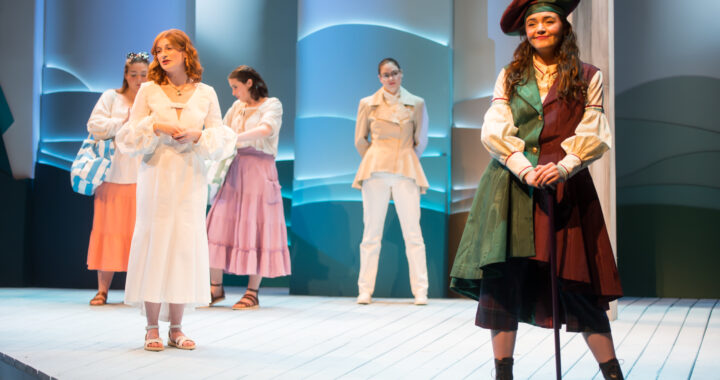From Keggers to Closing: Celebrating Seacobeck Hall
4 min read
UMW Digital Archives
By DELLA HETHCOX
After 84 years of serving hungry students, Seacobeck Dining Hall will say goodbye at the end of this semester.
Seacobeck opened in the spring of 1931 during the tenure of President Morgan Combs. Named after an Indian village that existed in the same location, Seacobeck cost the university $41,000 to build and was designed by the Charles M. Robinson Architectural firm.
The grand opening of the building occurred on May 19, 1931. Hundreds of guests, along with college and state officials, celebrated the elegant building’s opening and its luxurious interiors.
The dome room, now nicknamed “the lobby,” was furnished with Chippendale mirrors and tables, Persian rugs, rich draperies and luminous lighting. However, the crown jewel of Seacobeck was the Italian marble fireplace, which was decorated by students for holidays such as Thanksgiving and Christmas.
Seacobeck was frequently used to host events such as receptions, alumni dinners, faculty luncheons and university anniversaries. During the hall’s early history, the basement housed the Home Economics Department (a major that would be phased out in 1968).
For the twentieth anniversary of UMW (then called Mary Washington College) Seacobeck was featured on the souvenir program given to the participants, and the hall was used for the luncheon over which President Combs presided in conjunction with E. Lee Trinkle, president of the State Board of Education.
Between 1969 and 1972, Seacobeck underwent renovations to improve food services for the UMW community. The kitchen in particular underwent a complete renovation and brand new equipment was installed. Seacobeck later underwent another renovation in 2006, when the college partnered with a new food supplier, Wood Company, which would later be known as Sodexo. These later renovations made the building a popular eating spot for faculty and students.
However, Seacobeck was not always seen in such a positive light, especially for the students. College eateries have always been a point of contention for students; it’s a rite of passage for students to find fault with the greasy, starchy cafeteria food.
Students frequently, albeit lovingly, referred to Seacobeck as “Sickobeck” or “Seacobarf.” The dining hall often found itself in opinion pieces in The Bullet with irate student comments. William Crawley, UMW professor of history and American studies, documented the sometimes-strained relationship between the students and Seacobeck in his book, “A Centennial History,” which documents UMW: A History.
Crawley stated, “There were complaints about dirty dishes, check in hassles and surly administrators.”
In addition, The Bullet called for a boycott of the catering service of Seacobeck in Oct. 1979.
In a 1959 article, The Bullet published seven student suggestions for improving the conditions of Seacobeck. Students requested more food variety in addition to demands for better desserts, warmer food and better food safety guidelines for the food servers. One student, Sandy Holt, class of 1960, echoed student opinion about the quantity and quality of the food being served.
“I’m not saying that we don’t get enough food,” said Holt. “We do; exactly enough to keep us alive. It only seems that the quality and variety could be improved.”
The article concluded that $157.50 per semester was too much for the services provided by Seacobeck. An anonymous student said, “as far as we are concerned, $157.50 a semester is a total waste. Luckily, we have fine kitchens in our dorms (no doubt put there by some architect who made the error of eating at Seacobeck).”
Over the past year, Seacobeck celebrated its history with a series of buffet dinners commemorating each decade. Although this Wednesday the final official dinner was served, complete with white tablecloths echoing past meals and traditions, the dining hall will remain open until the end of the academic year.
However, students found a way to redeem their complaints of terrible food by hosting keg parties in the basement of Seacobeck after the ballroom of Ann Carter Lee Hall proved insufficient for the spillage of beer. The basement was able to withstand four-hour keg parties during the seventies and the eighties. It should be noted, however, that during this time the legal drinking age in Virginia was just eighteen years of age.
Throughout UMW’s history, Seacobeck has been a constant for students, and saying goodbye to this historical fixture will have mixed emotions for current students, alumni and faculty.
For alumna Amy Zitzmann, a former historic preservation major who now works as a historic interpreter for Prince William County’s Historic Preservation Division, the closing is bittersweet. Zitzmann participated in the student coalition, Save Our School, in 2010 to preserve Seacobeck.
The outraged students banded together to protest the proposed demolition of Seacobeck following an announcement of the university’s master plan, which included razing the historic building to make way for a three-story student center. The University later rethought their master plan after the public outrage.
“Personally, I feel that Seacobeck is an integral part of the campus, as it was one of the ‘first four’ buildings here,” said Zitzmann. “I am proud to have been a part of the student coalition to save the building from being razed and am happy to see that the building will serve another use and still be preserved and protected for future students to enjoy.”
Although the dining facilities will no longer reside in Seacobeck, that does not mean the building will cease to be. New dining facilities will be housed in the new student center, and Seacobeck will be repurposed, although its new purpose is still undecided.











